In today’s fast-paced world, maintaining good physical health is more important than ever. Many people spend the majority of their day sitting at a desk or engaging in sedentary activities, which can lead to poor posture, muscle imbalances, and limited mobility. Thankfully, there is a solution to combat these issues and improve our physical health – mobility training.
What is Mobility Training?
Mobility training is a form of exercise that focuses on improving joint mobility, flexibility, and overall movement patterns. Unlike traditional strength training or cardiovascular exercises, mobility training targets specific areas of the body to enhance range of motion, reduce muscle tension, and prevent injuries.
There are several benefits to incorporating mobility training into your fitness routine. Not only does it improve physical performance, but it also enhances overall well-being. By taking the time to work on your mobility, you can experience improved posture, reduced muscle aches and pains, and a greater sense of body awareness.
How to Get Started with Mobility Training
If you’re ready to start reaping the benefits of mobility training, here are some steps to help you get started:
- Evaluate Your Current Mobility: Before diving into any new training program, it’s essential to assess your current mobility. Take note of any areas of the body that feel tight, restricted, or have limited range of motion. This self-assessment will help you identify specific areas to target during your mobility training sessions.
- Consult with a Professional: If you’re new to mobility training or have specific concerns or injuries, it’s a good idea to consult with a trained professional, such as a physical therapist or mobility coach. They can assess your mobility, provide expert guidance, and create a personalized training plan that suits your needs.
- Start with Dynamic Stretches: Dynamic stretches are an excellent way to warm up your body and prepare for mobility exercises. These stretches involve continuous movement and are designed to increase blood flow and flexibility. Incorporate dynamic stretches for each major muscle group, focusing on the areas identified during your self-assessment.
- Progress to Mobility Exercises: Once you’ve warmed up, it’s time to move on to targeted mobility exercises. These exercises can include joint rotations, mobility flows, and specific stretches to help improve range of motion and increase flexibility. Start with exercises that target the areas you identified as needing improvement, and gradually increase the intensity and duration as you become more comfortable.
- Combine Mobility Training with Strength and Cardio: While mobility training is beneficial on its own, incorporating it into a well-rounded fitness routine can yield even better results. Pair your mobility exercises with strength training to build stability and support for your joints, and add cardiovascular exercises to improve overall endurance and fitness levels.
- Stay Consistent: Like any form of exercise, consistency is key when it comes to mobility training. Aim to incorporate mobility exercises into your routine at least two to three times a week, if not more. Consistency will allow your body to adapt and improve over time.
Remember, mobility training is a lifelong journey, and progress may take time. Be patient with yourself and celebrate even the smallest improvements. With dedication and consistency, you’ll notice significant changes in your physical health and overall well-being.
If you’re looking for more information and guidance on mobility training, Eastside Ideal Health offers a comprehensive program designed to improve mobility and enhance physical performance. To learn more, visit their website.
Start prioritizing your physical health today and embrace the power of mobility training. Your body will thank you!

